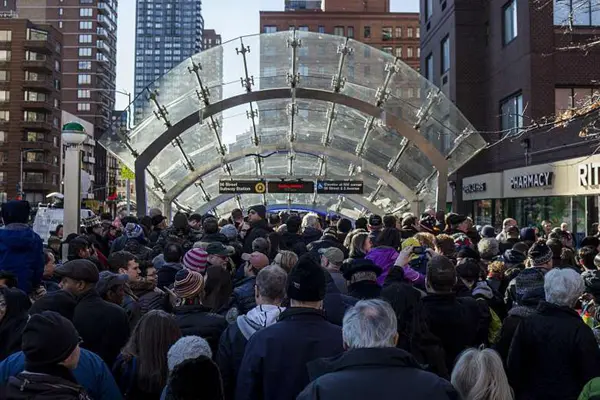The Second Avenue subway opened on Sunday, with thousands of riders flooding into its polished stations to witness a piece of history nearly a century in the making.
They descended beneath the streets of Manhattan's Upper East Side to board Q trains bound for Coney Island in Brooklyn. They cheered as their eyes filled with tears. They snapped selfies in front of colourful mosaics lining the walls of the stations.
It was the first day of 2017, and it felt like a new day for a city that had struggled to build this sorely needed underground line. In a rare display of optimism from hardened New Yorkers, they arrived with huge grins and wide eyes, taking in the bells and whistles at the three new stations.
"I was very choked up," Madam Betsy Morris, 70, said as she rode the first train to leave the 96th Street station at noon.
"How do you explain something that you never thought would happen? It's going to change the way everybody lives as far as commuting goes."
It was a major moment for New York City's sprawling transit system after decades of failed efforts to bring the line to one of the few corners of Manhattan the subway did not reach.
The opening of the first segment of the line - an extension of the Q train to 96th Street - promises to lighten the crush of passengers on the Nos. 4, 5 and 6 trains along Lexington Avenue, the most overcrowded subway line in the United States, which had been the only line on Manhattan's Upper East Side.
When the stations opened shortly before noon, they were quickly filled with giddy riders young and old, and strollers, suitcases and dogs - all familiar sights across the subway system.
But for all the excitement, the line, with just three new stops, is much more modest than the ambitious route running the length of Manhattan that was once envisioned. With the subway reaching its highest ridership levels since 1948, much of the ageing system is plagued by overcrowding and delays, even as subway and bus fares are expected to rise again in March.
Still, there was reason to cheer. The opening of a new subway line is a rare occasion in the US and comes at a time of mounting concern about the deteriorating state of the nation's infrastructure, from its roads and bridges to its public transit systems. Few new subway stations have opened in recent years, even as expansive subway networks have sprouted in Asia, and most American cities never built any in the first place.
The major subways in the north- east - in New York, Washington and Boston - are grappling with old equipment and funding shortfalls, with Washington experiencing a near meltdown over safety problems. With mounting bills for basic maintenance, these subways have largely failed to grow.
So the arrival of the long-delayed Second Avenue subway, which was first proposed in the 1920s, was a notable achievement for the often- vilified Metropolitan Transportation Authority, which runs New York City's network of subways, buses and commuter railroads. The first phase of the project took nearly a decade to build and cost about US$4.4 billion (S$6.3 billion).
Another opening-day celebrant, 15-year-old Ian Ma who lives nowhere near the line, said he has been enchanted by trains since he started rolling toy models on the floor as a child. "I feel like I've been waiting for this train my whole life," he said, seemingly speaking for many others.
(THE NEW YORK TIMES)
 简体中文
简体中文

